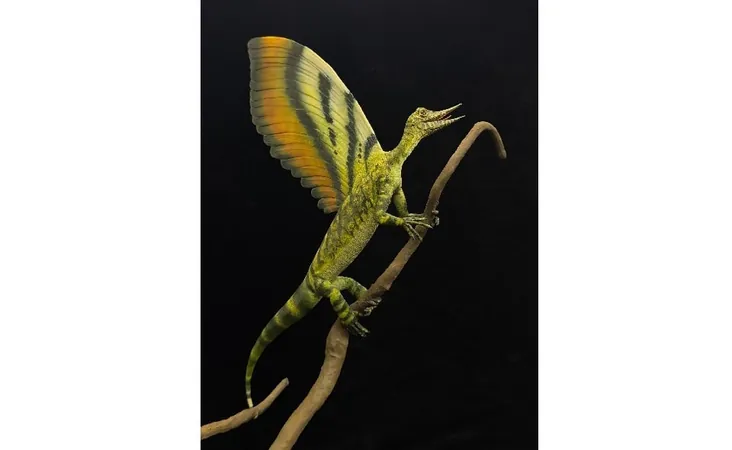
Ancient Reptile with Featherlike Plumes Discovered: A Breakthrough for Evolutionary Biology
2025-07-25
Author: Arjun
A Stunning Discovery Unveils 247-Million-Year-Old Mystery
In a groundbreaking revelation, German paleontologists have uncovered a 247-million-year-old fossil of a reptile boasting a bizarre array of plumes along its back. This remarkable find challenges our understanding of evolution and raises intriguing questions about the origins of feathers.
Transforming Our View of Feather Evolution
Stephan Spiekman, a leading paleontologist from the Stuttgart State Museum of Natural History, suggests that this discovery could revolutionize how scientists perceive feather evolution. "This could mean that the genetic mechanisms responsible for feather growth existed in early reptiles over 300 million years ago," said Spiekman. If proven true, it opens the door to the possibility that more prehistoric reptiles flaunted their own unique ornamental features.
Meet Mirasaura grauvogeli: A Marvel of Prehistoric Life
Officially named Mirasaura grauvogeli—Latin for "wonderful reptile"—this fascinating species pays homage to Louis Grauvogel, the French paleontologist who unearthed the fossil in 1939. Grauvogel, a factory owner with a passion for paleontology, pieced together an impressive collection of ancient remains before his passing in 1987. His daughter generously donated these treasures to the Stuttgart Museum in 2019.
From Misidentification to Major Find: The Evolution of Discovery
When Grauvogel originally excavated Mirasaura, he mistook its crest for a fish fin. However, decades later, the Stuttgart researchers uncovered the rest of the skeleton, leading to a more accurate identification of this intriguing reptile. This fossil was found to be in much better condition than its distant cousin, Longisquama insignis, a mysterious creature originally unearthed in 1969.
A New Perspective on Longisquama: The Feathered Connection?
The fossil record has long baffled scientists regarding Longisquama. Initially thought to be a reptile with unusual scales used for gliding, it later stirred controversy when some researchers proposed these features were akin to feathers. As the evidence surrounding feather evolution became clearer through discoveries of feathered dinosaurs, Longisquama's classification remained uncertain.
Distinct Yet Related: The Evolutionary Branch of Mirasaura and Longisquama
Thanks to Mirasaura, researchers have established a clearer lineage, confirming that both species belong to an extinct group of arboreal reptiles, separate from the ancestry of birds. The intricate nature of Mirasaura’s plumes revealed significant differences from true feathers, yet it shares some key features, such as melanosomes, which contribute to color.
The Purpose of Mirasaura’s Crest: Display or Thermoregulation?
While there’s speculation about how Mirasaura might have utilized its impressive crest, Spiekman dismisses the notion of it aiding in gliding or parachuting. Instead, he hypothesizes that it could have served a display purpose, similar to modern-day lizards. Ornithologist Richard Prum contemplates other possibilities, suggesting it may have been a living tissue layer, potentially used for thermal regulation.
A New Chapter in Reptile Adaptation and Evolution
Regardless of the eventual purpose of Mirasaura’s plumes, this discovery emphasizes the remarkable adaptability of reptile skin throughout history. As researchers delve deeper, they anticipate fresh debates and revelations about the evolutionary narrative connecting reptiles, feathers, and modern birds.


 Brasil (PT)
Brasil (PT)
 Canada (EN)
Canada (EN)
 Chile (ES)
Chile (ES)
 Česko (CS)
Česko (CS)
 대한민국 (KO)
대한민국 (KO)
 España (ES)
España (ES)
 France (FR)
France (FR)
 Hong Kong (EN)
Hong Kong (EN)
 Italia (IT)
Italia (IT)
 日本 (JA)
日本 (JA)
 Magyarország (HU)
Magyarország (HU)
 Norge (NO)
Norge (NO)
 Polska (PL)
Polska (PL)
 Schweiz (DE)
Schweiz (DE)
 Singapore (EN)
Singapore (EN)
 Sverige (SV)
Sverige (SV)
 Suomi (FI)
Suomi (FI)
 Türkiye (TR)
Türkiye (TR)
 الإمارات العربية المتحدة (AR)
الإمارات العربية المتحدة (AR)